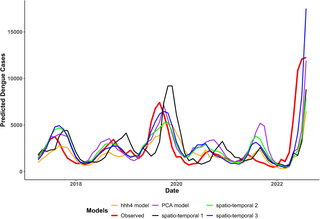Dengue fever, a vector-borne disease primarily spread by Aedes aegypti and Aedes albopictus mosquitoes, presents a serious public health challenge globally, particularly in tropical and subtropical areas. As of now, dengue is endemic in over 125 countries. The disease has seen a dramatic rise in cases, with incidences skyrocketing tenfold from 2000 to 2019, culminating in over 5 million reported occurrences, and an alarming 6.5 million cases recorded in 2023. The situation escalated further in the early months of 2024 when more than 13 million cases were reported, suggesting that actual numbers might be even higher due to underreporting. The economic toll of dengue was approximated at USD 8.9 billion in 2013 due to hospitalization and loss of productivity.
Most dengue cases present with mild symptoms or are subclinical, although approximately 2-5% of symptomatic patients succumb to severe forms which can include bleeding and shock. Supportive treatments typically include fluid replacement, depending on the severity. Historical prevention strategies have centered around vector control and measures to avoid mosquito bites, yet cutting-edge approaches like releasing genetically modified or Wolbachia-infected mosquitoes remain underutilized. While there are various vaccines that have shown efficacy in clinical trials, their adoption has been slow, attributed to numerous obstacles.
Vietnam has been particularly hard-hit, being classified as a high-incidence region for dengue. In 2023, the country recorded approximately 369,000 cases of dengue—the second-highest national total globally—with estimates suggesting that around 1.1 million cases occurred in 2021 after adjusting for underreporting. The Mekong Delta Region (MDR) has been particularly affected, accounting for 40-50% of the country’s total dengue cases from 2000 to 2016. Factors such as urban expansion, temperature fluctuations, and hydrometeorological changes significantly influence dengue incidence in Vietnam.
In response, the Ministry of Health in Vietnam has established a dengue prevention framework, primarily employing reactive strategies linked to reported cases. The focus has typically been on initiatives such as monitoring mosquito populations, community education to eliminate breeding grounds, and localized insecticide application. However, the reactive nature of these measures may fall short, often implemented post-outbreak, thereby missing opportunities for preventative action.
Recognizing the need for more proactive approaches, researchers have devised ensemble models to forecast dengue incidence effectively. The ensemble models have been created to predict dengue occurrences at the district level in the MDR, aspiring to fill the gaps present in previous provincial-level models. By integrating geographical and administrative features unique to dengue control programs, this study aims to provide localized predictions that could significantly enhance disease management strategies.
The ensemble model incorporates various probabilistic forecasts for 112 districts, leveraging a combination of meteorological, epidemiological, sociodemographic, and intervention data. This innovative approach not only improves prediction accuracy but also aligns with the operational scale at which vector control measures are implemented in Vietnam. By merging three successful modeling approaches into an ensemble, the accuracy and calibration of predictions across different climatic conditions and demographic profiles have improved.
In conducting this study, key findings revealed notable seasonal patterns in dengue incidence, strongly correlating with weather conditions. Between 2004 and 2022, an astounding 648,219 dengue cases were recorded in the MDR, predominantly during the rainy season. This statistical analysis provided foundational insights into environmental influences on dengue transmission, confirming that high rainfall corresponds to increased case counts, underscoring the necessity for adaptable public health programs.
A total of 72 models were tested for forecasting efficacy, leading to the creation of an ensemble model that outperformed individual models regarding accuracy. For example, during a significant dengue wave, a 3-month lead-time forecast demonstrated an ability to signal upward trends well before outbreaks fully manifested, granting public health officials critical time for preparedness.
The success of the ensemble model also lay in its ability to classify outbreak and non-outbreak periods accurately. Higher calibration was observed when using stricter outbreak thresholds, which is essential for resource-limited settings. Understanding the variability of model performance based on geographic areas provided valuable insights into local challenges, particularly in districts with complicated environmental dynamics.
Despite its strengths, challenges persist, especially concerning epidemic thresholds and how real-time dynamics during unprecedented events—such as the COVID-19 pandemic—may affect the predictive accuracy of models. The significant deviations noted in certain years highlighted the evolving nature of disease transmission and the necessity for ongoing model adjustments.
The implications of this study are profound for dengue mitigation strategies in Vietnam, particularly within the MDR. By harnessing district-level forecasts, local health authorities can implement timely, tailored interventions such as targeted vector control measures based on real-time risk assessments. These predictive efforts support the transition from reactive to proactive public health strategies, which aligns well with Vietnam’s ongoing initiatives to manage climate change—a recognized contributor to the spread of vector-borne diseases.
In conclusion, the development of an ensemble model for dengue prediction marks a critical advancement in public health capabilities in Vietnam. This localized approach not only addresses immediate control needs but also serves as a model for integrating climate data into health outcome predictions, equipping health authorities to respond more effectively to dengue outbreaks. As further refinements continue, such models can help ensure that Vietnam’s health systems are better prepared and more resilient against the dengue threat moving into the future.






